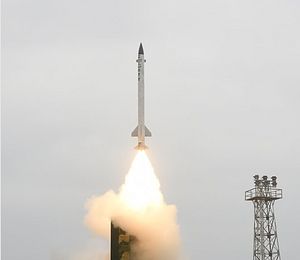On August 2, the Defense Research Development Organization (DRDO), the Indian Ministry of Defense’s (MoD) research and development wing, conducted a successful test of its indigenously designed and built Advanced Air Defense (AAD)/ Ashvin Advanced Defense interceptor missile from Abdul Kalam Island, home to the Indian military’s principle missile test facility, the Integrated Test Range, off the coast of Odisha in the Bay of Bengal.
The AAD missile, a hit-to-kill interceptor, successfully destroyed an incoming medium-range ballistic missile target amid multiple electronically simulated dummy warheads used as decoys. It was the first time that the AAD was tested against multiple targets, and it constitutes a major milestone in India’s quest to develop a homegrown ballistic missile defense system. It appears that this was the first successful live fire test of a new indigenous imaging infrared (IIR) seeker, developed by DRDO, to distinguish between incoming warheads and decoys.
“The endo-atmospheric missile, capable of intercepting incoming targets at an altitude of 15 to 25 [kilometers] was launched against multiple simulated targets of 1500 [kilometers] class ballistic missile,” the Indian MoD said in an August 2 statement. “One target among simultaneously incoming multiple targets was selected on real time, the weapon system radars tracked the target and the missile locked on to it and intercepted the target with a high degree of accuracy.”
The test was tracked by a number of electro-optical tracking systems, radars and telemetry stations. According to the MoD, “all the mission objectives were successfully met.” DRDO last test fired the AAD in December 2017. Other tests were conducted on March 1 and February 11 2017 as well as in May 2016 and November 2015. In past tests, Prithvi-II or III tactical surface-to-surface short-range ballistic missiles stood in as ballistic missile targets. It is unclear what type of missile was used for the August 2 test. (One possibility is the Agni-II medium to intermediate range ballistic missile.)
As I reported in December 2017:
The single stage solid rocket-propelled AAD/Ashin interceptor missile is part of India’s planned two-layered ballistic missile defense (BMD) system and is designed to shoot down incoming enemy missiles in the endo-atmosphere at altitudes of 20-40 kilometers. [15-25 kilometers, according to the Indian minister of defense] AAD missiles are terminal phase interceptors capable of intercepting missiles after they re-enter the earth’s atmosphere.
Furthermore, as I explained elsewhere:
Following the end of the Kargil War and in reaction to China and Pakistan’s growing missile arsenals, India has been working since 1999 on a two-tiered ballistic missile defense system with the PAD [Prithvi Air Defense (PAD)/Pradyumna Ballistic Missile Interceptor] and PDV [Prithvi Defense Vehicle] designed to destroy missiles at exo-atmospheric altitudes of 50–150 kilometers (some sources say 180 kilometers).
Both PAD and PDV are designed for mid-course interception in other words intercepting the incoming ballistic missile in space after the rocket burns out. AAD constitutes the second-tier defense against ballistic missile threats. India is in the process of supplementing its indigenous BMD shield with an additional weapon system to bolster air defenses over New Delhi: the upgraded version of the Kongsberg Defense & Aerospace/Raytheon National Advanced Surface-to-Air Missile System (NASAMS), designated NASAM-II. Acquisition costs are estimated at around $1 billion.

































